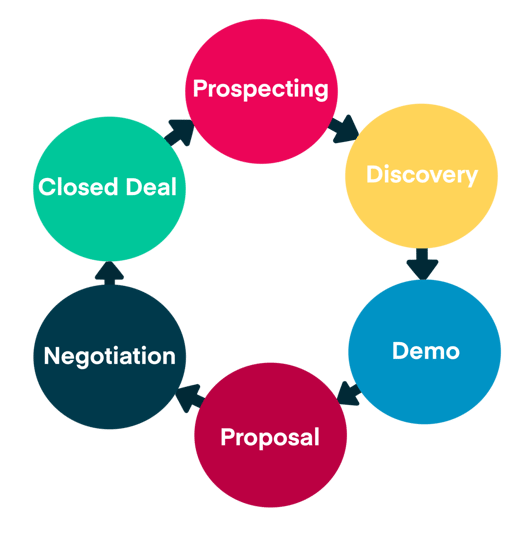"How to shorten the sales cycle?" This question bothers every sales leader who's looking for optimal ways to reach quarterly targets.
The truth is, there's no surefire blueprint that magically speeds up sales cycles on a case-by-case basis. But luckily for you, there're plenty of useful techniques you can leverage to streamline your sales cycle and maximize efforts.
What is a sales cycle?
The sales cycle is a repetitive process that covers everything from the point of the first contact with prospects up until their subsequent conversion into a client.
Needless to say, the specifics of your organization predefine the length of your sales cycle.
In a B2B or SaaS company, you're expected to go through several stages during your sales cycle:
- Lead generation/Prospecting
- Discovery
- Demo
- Proposal
- Negotiation (optional)
- Closed deal

Obviously, depending on what you specialize in, these stages may look slightly different. However, all these phases play a crucial role in the length of your sales cycle, and in order to speed up the process, you need to optimize it at every step of the way.
What Is The Optimal Length Of The Sales Cycle?
Ruler Analytics study shows that 52.3% of companies report having an average sales cycle lasting between one and three months.
On the other hand,18.8% claim to have cycles that last longer than four months.
Several factors contribute to the length of the cycle: industry, business model, company size, etc.
On average, companies offering lower prices experience a shorter sales cycle as there's less risk involved in the process, and vice versa. The process expands accordingly if you offer more expensive and exclusive goods or services.
Now, if you eliminate these obvious factors, what other issues can cause a prolonged cycle?
According to the same study, unqualified leads in the sales pipeline (46,3%), targeting the wrong audience (36,3%), and poor sales and marketing alignment (32,5%) are among the leading causes of the problem.
Tips that Will Help You Shorten the Sales Cycle
As mentioned before, there's no universal blueprint that will fit every bill. However, if you feel that you need to optimize the process and eliminate obstacles on your way to closing more deals in a shorter span of time, we have compiled a list of the eight most effective sales cycle shortening tips.
1. Structure and plan out every prospect conversation
Do you actually know the goals you're pursuing at every stage?
If you don't have a plan and just act intuitively, you might want to reconsider your approach. Every conversation with a prospect should be based on tangible and clear goals.
- What results do you expect after the first, second, and third conversation?
- What are your strengths, secret weapons?
- Do you have some weaker spots that you need to work on before engaging with the prospect?
- What is the end goal you would like to reach with this particular prospect?
Ask yourself these questions, and based on the answers, you will be able to build a solid plan that will account for any scenario that might happen during a prospect conversation.
Not many people can boast of having excellent improvisation skills, and even if you're great at it, it's always better to structure your work to have a clear path in mind.
2. Talk to the right person
This tip seems quite obvious, but again, targeting the wrong audience is among the leading causes of the stretched-out sales cycle. A lot of sales reps spend an immense amount of time convincing the wrong person. Thus, qualifying leads first is a must.
Have you met MEDDIC? MEDDIC is a lead qualifying approach that helps you target the right lead faster and more precisely. The acronym stands for Metrics, Economic buyer, Decision criteria, Decision process, Identify pain, and Champion. Let's break it down:
Metrics – find out what qualifiable gains a prospect intends to get from your solution. Use these metrics to point out the economic benefits of your product.
Economic buyer – find out who is the company's economic buyer, and thus, has the power to make the purchasing decision.
Decision criteria – find out what influences the prospect's decision-making process, and try to adjust your strategy accordingly.
Decision process – this stage includes identifying people responsible for the decision, the timeline of their decision-making process, and any approval processes in place. The more you know about the decision process, the smaller the chances of you losing the prospect.
Identify (and subsequently indicate and implicate) pain -- find out the customer's pain points and try to show how your solution solves them.
Champion – it refers to stakeholders who have the power and influence, work for the same company, and have a vested interest in it. These "champions" will help you sell your product more effectively.
MEDDIC approach covers a broader spectrum of the sales process and is oriented towards stakeholders’ improved buying experience. As a result, you benefit from a higher success rate as you acquire more qualified leads and target the right person.
3. Create a personalized experience for each prospect
Finding a personalized approach to every prospect is, without any doubt, key to closing a deal. Any sales rep will tell you that it's one of the first things they learn when starting their career. However, it often happens that reps ignore this rule and treat prospects as another "summit" to conquer.
The more you listen to your prospect and establish a warm, friendly environment, the more they realize that your solution is the right choice for them.
Here're a couple of tips to help you create a personalized experience for every client:
- Mention their name as often as possible (as long as it feels natural). Start your emails and phone conversations by addressing them by their name. This way, they won't feel like it's a mass pitch.
- Take notes of important "key moments" in a conversation to later refer to them.
- Highlight the aspects of your solution that cater to the specific needs of your prospect. Don't overload them with unnecessary information about features they don't really need or won't use regularly.
4. Align with your marketing team on sales goals
A mismatch between sales goals and marketing strategies is another item on the list of the top 3 causes of a longer sales cycle.
Often, marketing specialists and sales reps are working on opposite sides of the sales funnel. And even though they have the same goal in mind, poor cooperation in key aspects can negatively impact your bottom line.
For instance, according to some sales teams, only 7% of leads they receive from marketing campaigns are qualifiable.
With this in mind, establish understanding and mutual goals between sales leaders and marketing managers to keep improving the sales process.
5. Don't delay the price talk
Make sure to unveil the actual price of your services early on in client conversation. Of course, we’re not talking about using it as a conversation starter. Just make sure you don't save it for one of the last stages in the cycle.
Price transparency creates mutual trust and understanding between you and your prospect. So, if you're tempted to leave this information for "dessert," don't be surprised when you get ghosted or have to deal with various objections suddenly flooding your inbox.
6. Keep your CRM up-to-date to get rid of old contacts
Don't put this task away, as it will only result in an ineffective workflow. Cleaning up your CRM regularly and keeping your contact list neat and updated will save you a lot of precious time that you'll be able to spend on fulfilling company goals.
Make sure to perform a scrupulous revision of your prospect list and eliminate every contact that has unsubscribed or bounced. Additionally, structure your contacts in a way that will show you their last activity and interaction with you. This way, you will know whom to target first and whom to put into the cold lead list.
7. Use incremental closes
Incremental closes help you prime your prospects for the purchase and close the deal faster.
What we recommend is to introduce these closes as a series of smaller commitments that will get the prospect into the habit of saying "yes," and make them feel more invested in the deal.
Our first tip about structuring your every call will come in handy here since you'll need to outline the list of requests at the end of each call, which will grow in significance and importance with every new interaction. These requests should be beneficial for both you and your prospect as it reduces the chances of rejection.
For example, after the discovery call, ask your prospect for additional contact details to send them further information or reach out for other reasons. And, after you've presented your services, ask them to get in touch with other stakeholders involved in the decision-making process.
8. Invest in automation software
Just think about it: 21% of the SDR's working time is dedicated to writing emails. And how many hours do they spend on updating CRM, putting all the notes together, and other organizational tasks instead of making an actual impact on the company's bottom line? To tell you the truth, these numbers can be unsettling. So the question is how to optimize and automate the process.
There're many sales automation tools out there that can help you tackle this issue effectively. Such software allows your salespeople to focus on main goals and spend less time performing secondary tasks.
For example, Unique sales software records and transcribes customer conversations and updates your CRM automatically. There's no need to take notes anymore, – this software will capture key moments in every conversation and provide you with analytic tools to better understand your client’s needs and pains.
The Unique app significantly decreases cognitive load for sales reps so that they can focus on what really matters.
The better the process is organized for every sales rep in your team, the better environment you create to ensure shorter sales cycles.
Shortening Your Sales Cycle Is Possible If You're Ready To Work On It
While there's no magic solution to the problem of a longer-than-expected sales cycle, a good sales strategy includes optimizing the process at every step of the customer journey. Use every means available to orient your sales team’s workflow towards reaching goals, and eliminate all possible obstacles in their way.



